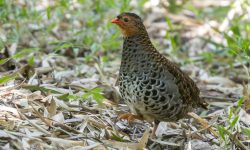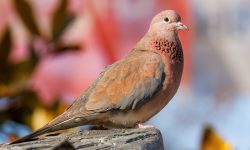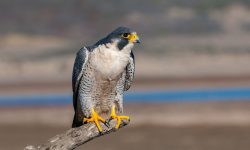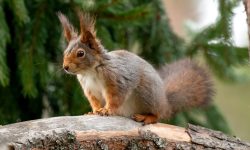Squirrels are some of the most familiar and fascinating mammals found in forests, parks, and even urban areas worldwide. Known for their bushy tails and nimble movements, these creatures come in a wide variety of species. This article introduces you to 49 different types of squirrels, highlighting their unique appearances and habits.
The variety among the types of squirrels is impressive, ranging from small tree squirrels to large ground dwellers and gliding squirrels that can soar through the air. Each type has its own distinct characteristics shaped by the environment it lives in, making squirrels a diverse and interesting group of animals to study and observe.
In this guide, you’ll find detailed descriptions, identification tips, and vivid images for all 49 types of squirrels. This resource aims to help you recognize and appreciate these lively animals in their natural habitats or right outside your window. Dive into the captivating world of squirrels and discover what makes each type special.
Types of Squirrels in North America
Sciurus carolinensis

The Eastern gray squirrel is one of the most widespread and recognizable squirrels in North America. It has gray fur with a white belly and a large, bushy tail that aids in balance and warmth. Adults typically weigh between 400 to 600 grams and measure up to 20 inches in length, including the tail.
This squirrel is native to the eastern and midwestern United States and parts of southern Canada, thriving in deciduous and mixed forests as well as urban parks and neighborhoods. It is highly adaptable and often builds nests called “dreys” out of leaves in tree branches or uses tree cavities for shelter.
Eastern gray squirrels are diurnal and active year-round. Their diet mainly consists of nuts, seeds, fruit, tree bark, and fungi. A fun fact is that they practice “scatter hoarding,” burying thousands of nuts during autumn to retrieve in winter, though many forgotten nuts help with forest regeneration.
Sciurus niger

The Fox squirrel is the largest native tree squirrel in North America, measuring up to 28 inches long including its tail. It has a variable coat color ranging from gray to rust-red, with a pale or orange underside, and a long bushy tail often tinged with cinnamon hues.
This species is common in the eastern and central United States, particularly in areas with open woodlands, oak savannas, and even agricultural landscapes. It is more tolerant of fragmented habitats than other squirrels and can often be seen foraging on the ground.
Fox squirrels feed on acorns, hickory nuts, corn, berries, and insects. They build nests high in trees or take over old woodpecker holes. A fun fact is that they often “fake bury” nuts to throw off potential thieves like other squirrels or birds.
Tamiasciurus douglasii
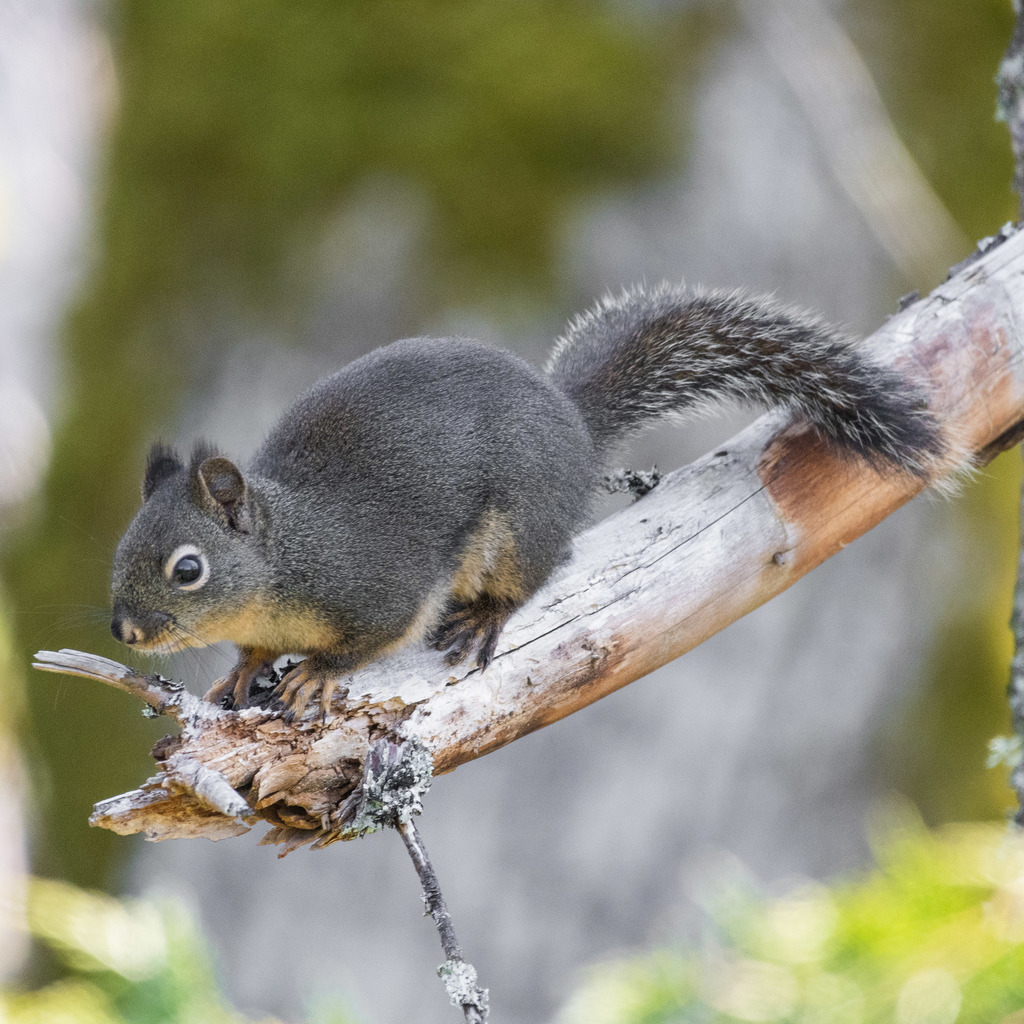
Douglas’s squirrel, often called the “chickaree,” is a small, lively squirrel with a dark brown or reddish back and a pale orange belly. It has a relatively short tail compared to tree squirrels and emits a distinctive, rapid chattering call when alarmed.
This species is found along the western coast of North America, from British Columbia through the Pacific Northwest to central California. It inhabits coniferous forests, especially areas dominated by Douglas fir, for which it is named.
Douglas’s squirrels are territorial and aggressive in defending their food caches, often storing conifer seeds in large, central “middens.” A fun fact is that these squirrels are known to fiercely chase off intruders and even throw pinecones at predators or rivals.
Tamiasciurus hudsonicus
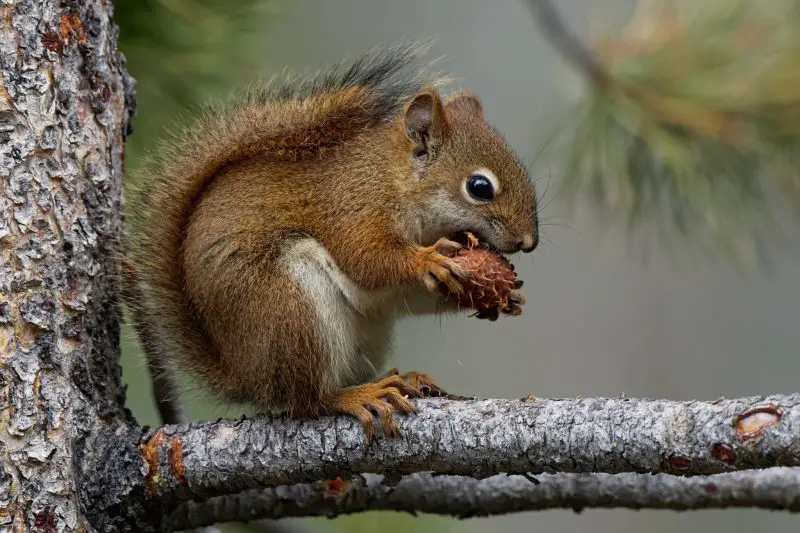
The American red squirrel is a small, reddish squirrel with a white belly and a bold, bushy tail. It has a prominent eye ring and is known for its loud, trilling calls used to defend its territory.
Found across boreal forests from Alaska to the northeastern United States, this species prefers coniferous forests but can also be seen in mixed woods. It constructs nests in tree branches or uses abandoned woodpecker holes.
Red squirrels feed primarily on conifer seeds but also consume fungi, fruits, bark, and bird eggs. They are known for creating large caches of food to survive winter. A fun fact is that their middens can persist and grow for years, passed down across generations.
Tamiasciurus fremonti
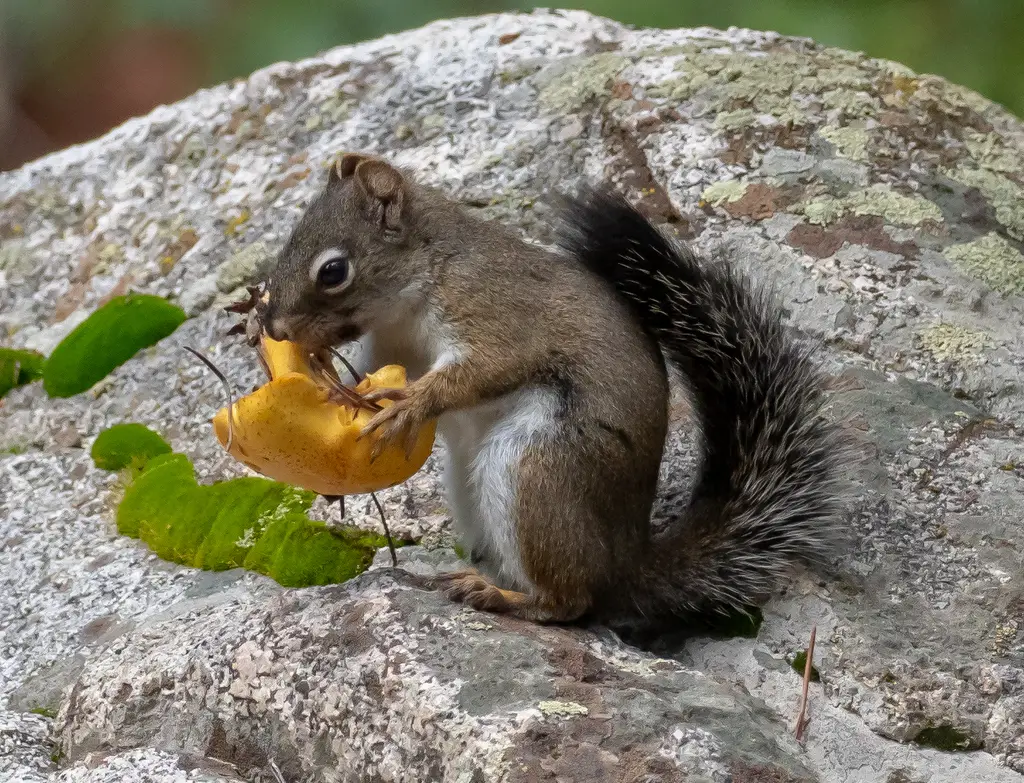
The Southwestern red squirrel is closely related to the American red squirrel but adapted to high-elevation forests in the southwestern United States. It has reddish-brown fur, a white underbelly, and a tail that appears slightly flatter than other red squirrels.
Its distribution is limited to isolated mountain ranges, such as the Sierra Madre and parts of Arizona and New Mexico, where it inhabits cool, moist spruce-fir and mixed-conifer forests. Due to habitat fragmentation, some populations are now considered vulnerable or endangered.
The Southwestern red squirrel is territorial and solitary, feeding mostly on pine cones, mushrooms, and tree bark. A fun fact is that its vocalizations and size can differ slightly from northern red squirrels, suggesting a unique adaptation to its mountainous environment.
Ictidomys tridecemlineatus
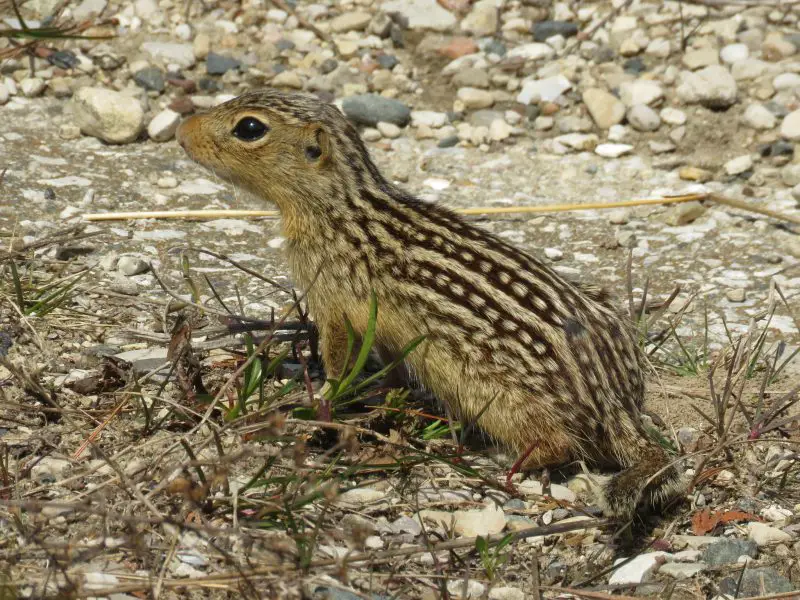
The thirteen-lined ground squirrel is a small, slender rodent with distinctive fur marked by thirteen alternating light and dark stripes and spots along its back. Its short tail, small ears, and golden-brown color make it easy to identify on grassy plains.
This squirrel is native to central North America, commonly found in prairies, grassy fields, golf courses, and even cemeteries. It prefers open areas with short vegetation and well-drained soil where it can dig burrows.
Thirteen-lined ground squirrels are diurnal and hibernate for up to seven months during winter. They feed on seeds, grasses, insects, and small vertebrates. A fun fact is that their body temperature drops close to freezing during hibernation, and their heart rate slows to just a few beats per minute.
Ictidomys mexicanus
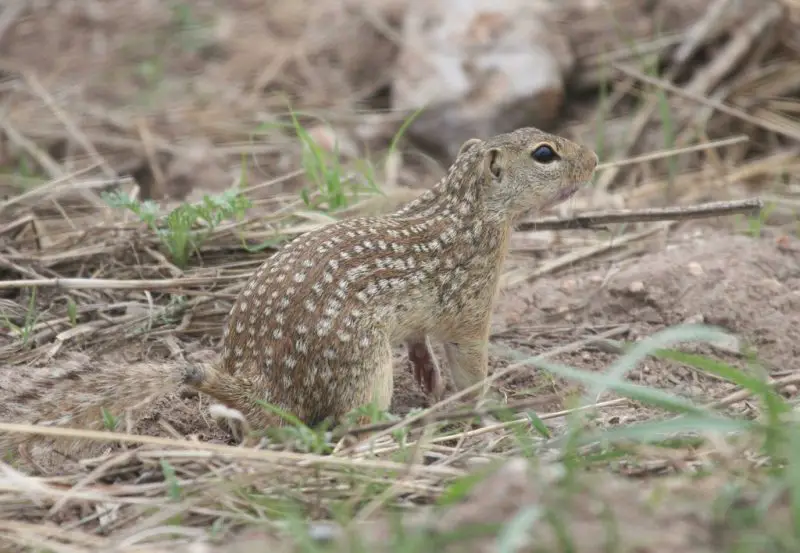
The Mexican ground squirrel resembles the thirteen-lined ground squirrel but is generally larger and has a more reddish-brown coat with a series of pale spots along its back, rather than full stripes. Its tail is slightly bushier, and it tends to have a more robust body.
It inhabits southern Texas and northeastern Mexico, living in dry grasslands, desert margins, and scrubland. It prefers sandy or loose soil for burrowing and avoids dense vegetation.
This squirrel feeds on seeds, roots, insects, and occasionally small animals. It is less well studied than other ground squirrels but is known to be active during warmer months and to hibernate during winter. A fun fact is that it can climb shrubs and low trees despite being a ground-dwelling species.
Otospermophilus variegatus
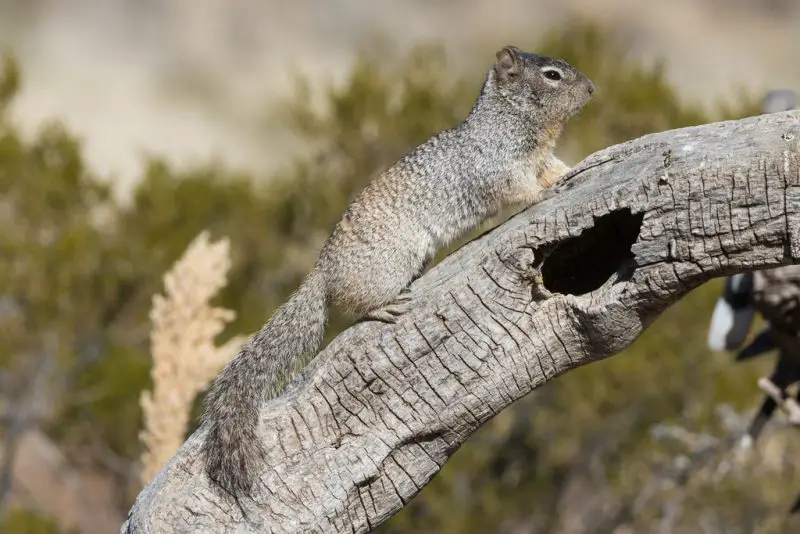
The rock squirrel is one of the largest ground squirrels in North America, easily recognized by its grayish-brown, mottled fur and long, bushy tail. Its body can grow up to 18 inches long, and it closely resembles a tree squirrel in appearance.
This species ranges across the southwestern United States and into Mexico, often seen among rocky outcrops, canyon walls, and dry deserts. It builds extensive burrow systems in crevices or under rocks for shelter and protection.
Rock squirrels are omnivorous, feeding on fruits, seeds, nuts, insects, and even small birds. A fun fact is that they are known to sunbathe on rocks and will alarm call loudly when predators are near. They can also enter a torpid state in colder months, similar to hibernation.
Spermophilus richardsonii
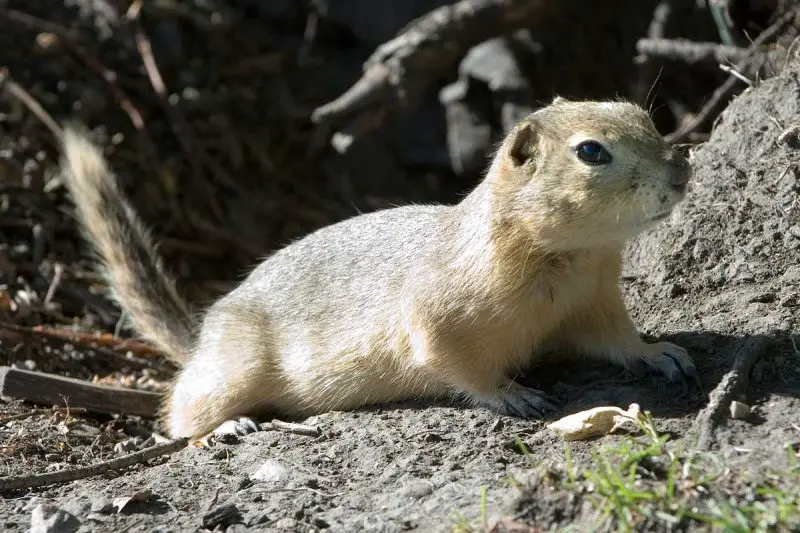
Richardson’s ground squirrel is a small, tan-colored squirrel with a short tail and round body, often mistaken for a prairie dog due to its similar size and posture. Its fur is plain brown without noticeable markings, and it has dark eyes set in a rounded face.
Native to the northern plains of the United States and southern Canada, it prefers open grasslands and cultivated fields. It digs elaborate burrow systems with multiple exits and chambers for sleeping and food storage.
This ground squirrel feeds on grasses, seeds, and small invertebrates. It is highly social and often lives in colonies with coordinated alarm calls. A fun fact is that it can remain underground in hibernation for up to 8 months, surviving cold prairie winters.
Spermophilus franklinii
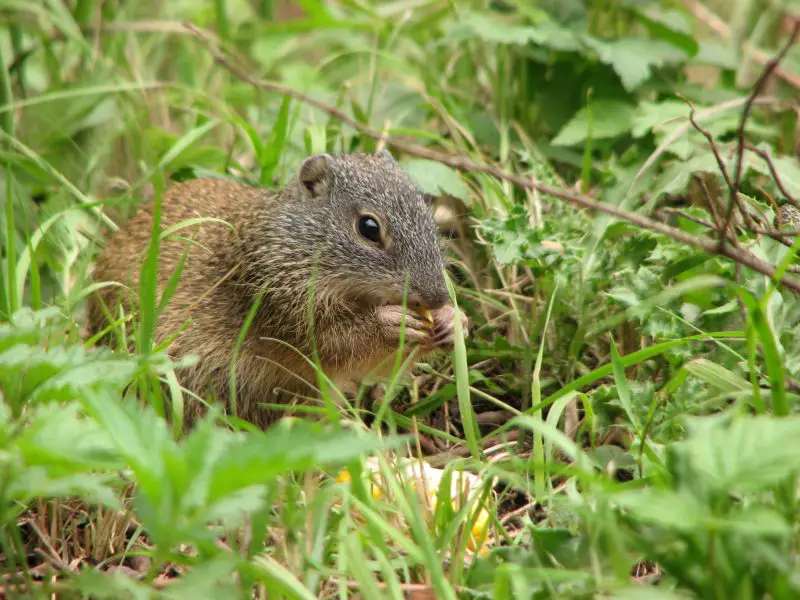
Franklin’s ground squirrel is a larger and darker species than many other ground squirrels, with grayish-black fur and a relatively long tail. It has a chunky build and a shy, elusive nature, making it harder to observe in the wild.
This squirrel inhabits tallgrass prairies, forest edges, and wet meadows in the central United States and parts of Canada. It avoids open spaces and prefers areas with dense vegetation for cover and burrow construction.
Its diet includes vegetation, fruits, insects, and sometimes bird eggs. Franklin’s ground squirrel is a strong swimmer and is known to cross streams when foraging. A fun fact is that it plays an important ecological role by dispersing seeds and controlling insect populations.
Urocitellus columbianus
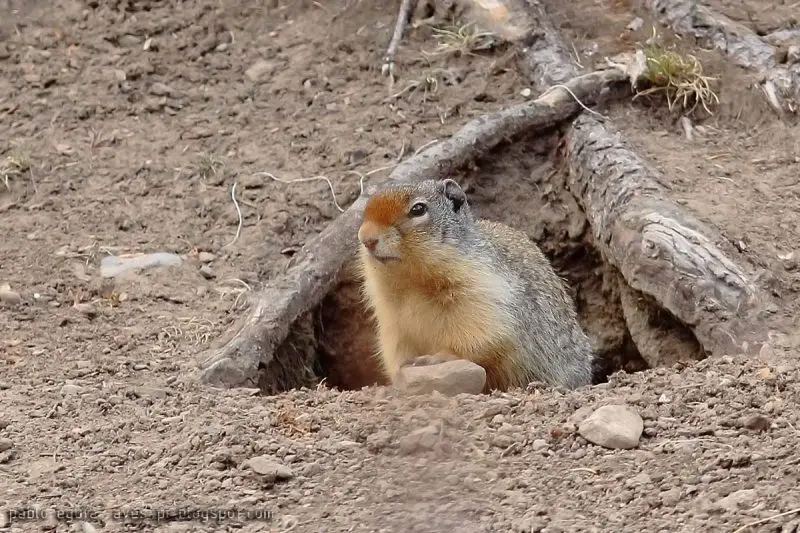
The Columbian ground squirrel is a medium-sized ground squirrel with a robust body and short limbs. It has a grayish-brown back speckled with lighter tones and a reddish face and legs. Its short tail is tipped with black and white, giving it a distinguished look.
Found in the Rocky Mountains and surrounding regions of the northwestern United States and southwestern Canada, this species prefers alpine meadows, forest edges, and grasslands. It is often spotted near burrow entrances, especially in sunny areas.
Columbian ground squirrels hibernate for 7 to 8 months, with some of the longest hibernation periods of any mammal. They feed on grasses, seeds, and insects during their active season. A fun fact is that males emerge from hibernation weeks before females to secure territory.
Urocitellus beldingi
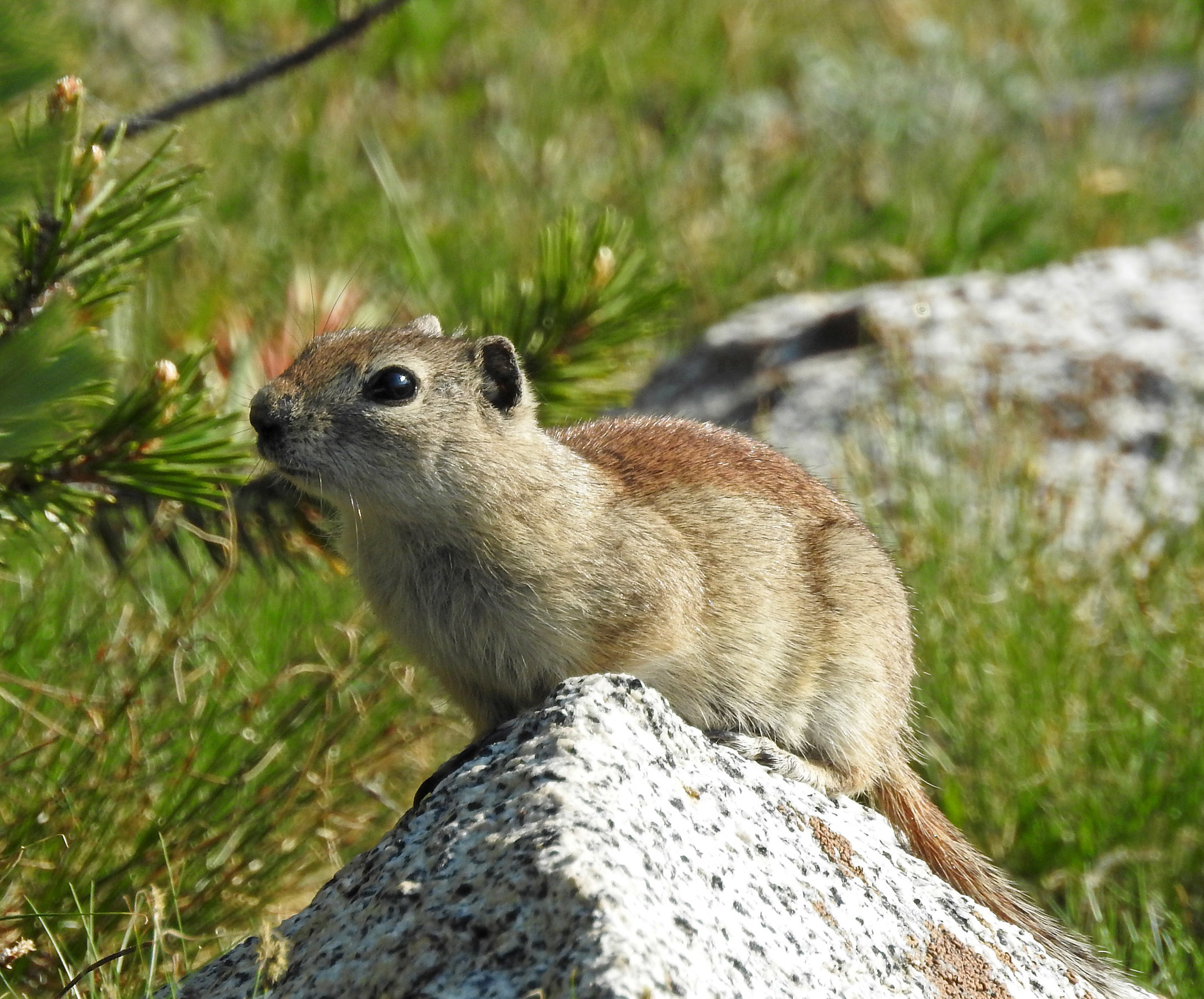
Belding’s ground squirrel is a small, grayish-brown rodent with a relatively short tail and minimal markings, except for a lighter belly. Its appearance is somewhat plain, which helps it blend into rocky or grassy habitats.
This species is native to the mountainous regions of the western United States, especially in the Sierra Nevada and Great Basin. It thrives in alpine meadows, sagebrush flats, and subalpine zones where vegetation is abundant during summer.
Belding’s ground squirrels are diurnal and spend much of the day foraging. Their diet includes forbs, grasses, and insects. They are highly social and use loud alarm calls to warn others of danger. A fun fact is that they only remain active above ground for about three months before beginning hibernation.
Urocitellus townsendii
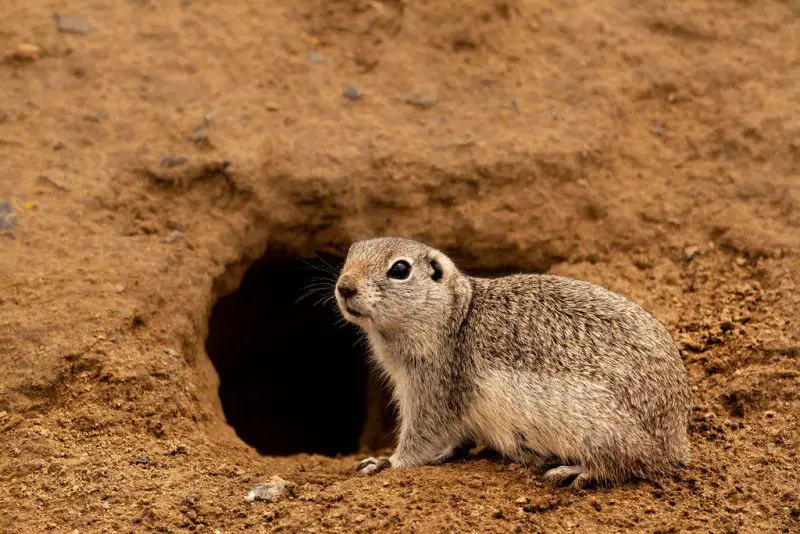
Townsend’s ground squirrel is a small, slim rodent with dull grayish-brown fur and a relatively short tail. It is one of the more inconspicuous ground squirrels, often blending in with the dry, sandy terrain it inhabits.
This species lives in the arid and semi-arid regions of the Great Basin and Columbia Plateau, preferring open desert scrub, grasslands, and sagebrush steppe. It burrows in loose soil and is most active in the early morning and late afternoon.
Townsend’s ground squirrels feed on grasses and seeds and can survive in extremely dry environments. They aestivate during the hottest parts of summer and hibernate in winter. A fun fact is that some populations may remain underground and inactive for up to nine months a year.
Marmota monax
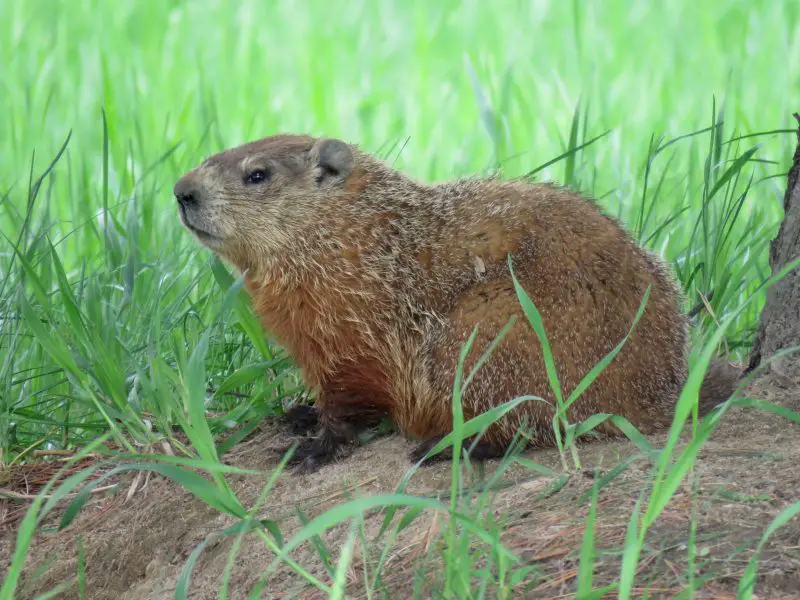
Also known as the groundhog or woodchuck, Marmota monax is a large, chunky squirrel with brownish fur, short legs, and a bushy tail. It has a broad, flat head with small ears and strong claws adapted for digging.
Groundhogs are widespread across the eastern and central United States and parts of Canada. They inhabit forest edges, pastures, and open fields, often near human settlements. They are known for their large burrow systems, which may have multiple chambers and entrances.
These squirrels are herbivorous, eating grasses, clover, fruits, and vegetables. They hibernate deeply in winter and are famous for “Groundhog Day,” a tradition based on their emergence from hibernation. A fun fact is that groundhogs can swim and climb trees when threatened.
Marmota flaviventris
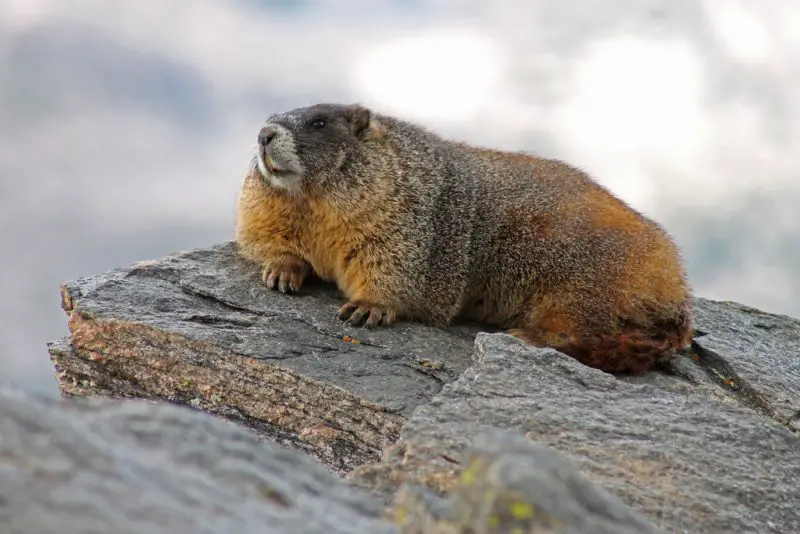
The yellow-bellied marmot is a large, burly ground squirrel with a thick body covered in brownish fur and a distinct yellow to orange patch on its belly. Its broad head, short ears, and bushy tail make it easy to distinguish from other marmots.
This species is found in the western United States and southwestern Canada, especially in mountainous regions such as the Rockies and Sierra Nevada. It prefers alpine meadows, rocky slopes, and open grassy areas near boulders where it can build deep burrows.
Yellow-bellied marmots are herbivores, feeding on grasses, flowers, and seeds. They hibernate for up to eight months, and their colonies are often made up of extended family groups. A fun fact: they communicate with loud whistles to alert others to danger, earning them the nickname “whistle pigs.”
Glaucomys sabrinus
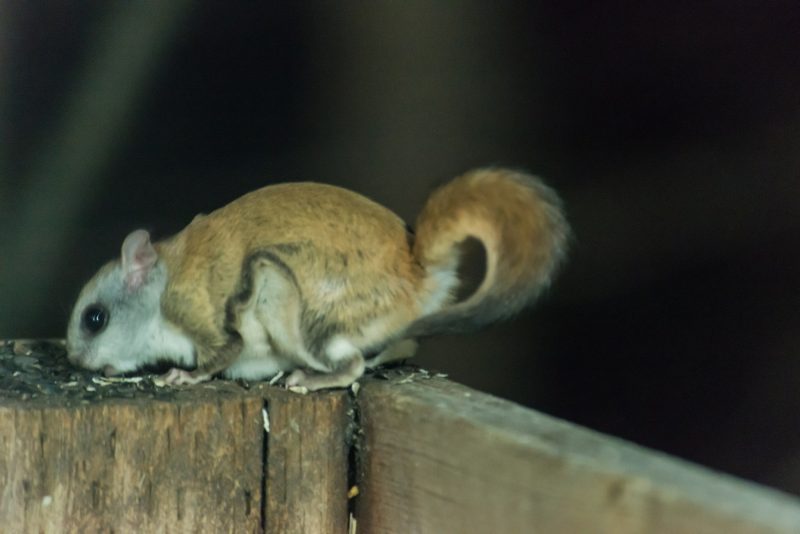
The northern flying squirrel is a small, nocturnal squirrel with a soft, grayish-brown coat and a creamy white belly. It has a flattened tail and a skin membrane called the patagium that stretches from wrist to ankle, allowing it to glide between trees.
This species inhabits coniferous and mixed forests across Canada, Alaska, and parts of the northern United States. It prefers dense woodlands with old trees and abundant snags for nesting.
Northern flying squirrels feed on fungi, lichens, seeds, and berries, playing a key role in forest ecology by dispersing fungal spores. A fun fact is that they are seldom seen due to their strictly nocturnal habits and silent gliding through the canopy.
Glaucomys volans
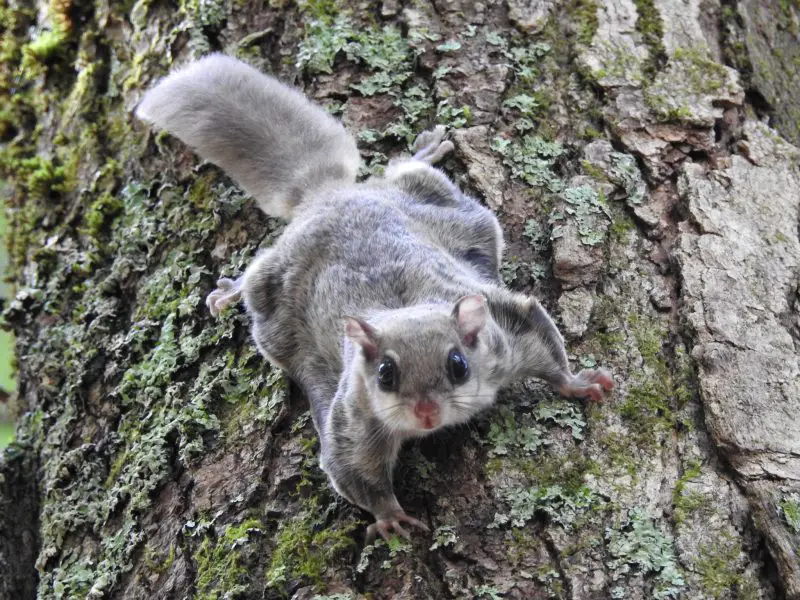
The southern flying squirrel is the smallest tree squirrel in North America, with soft gray-brown fur, large black eyes, and a pale underbelly. Like its northern cousin, it has a gliding membrane used to travel from tree to tree.
It inhabits deciduous and mixed forests throughout the eastern and southern United States. Southern flying squirrels are cavity dwellers and often nest in tree holes, abandoned woodpecker nests, or nest boxes.
They are omnivorous, eating acorns, seeds, fruits, fungi, and even bird eggs or insects. Southern flying squirrels are highly social and may huddle in groups to keep warm. A fun fact: their glides can cover over 150 feet in a single leap.
Glaucomys oregonensis
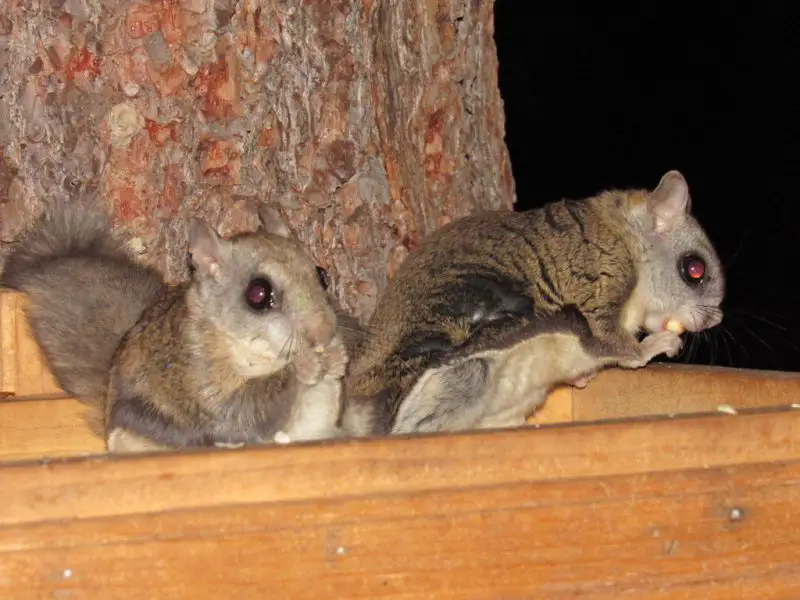
The Humboldt’s flying squirrel, once considered a subspecies of Glaucomys sabrinus, is now recognized as a distinct species. It closely resembles the northern flying squirrel, with soft brown fur and a gliding membrane, but is slightly darker in color.
This species is native to the Pacific coastal forests of northern California, Oregon, and southern British Columbia. It thrives in moist, dense forests dominated by conifers and uses tree cavities or leaf nests for shelter.
Humboldt’s flying squirrels are nocturnal and elusive, feeding on fungi, nuts, insects, and lichens. A fun fact is that this species was only identified as separate from the northern flying squirrel in 2017, making it one of North America’s newest recognized mammal species.
Types of Squirrels in Central and South America
Sciurus aureogaster
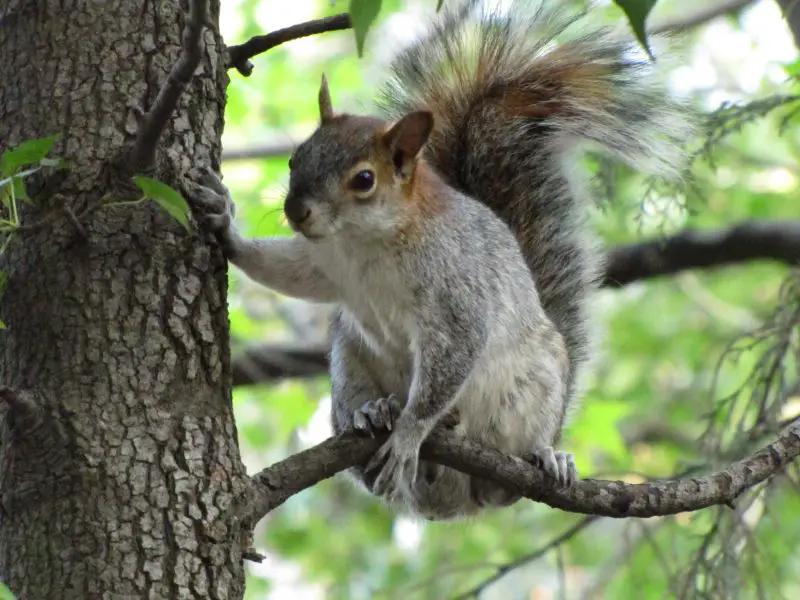
The Mexican gray squirrel is a medium-sized tree squirrel with a sleek, gray body, a white or buff-colored belly, and a large, bushy tail. Some individuals may display reddish hues depending on regional variations.
This squirrel is native to Mexico and Central America, where it inhabits tropical and subtropical forests, as well as urban and agricultural areas. It adapts well to human presence and is often seen foraging in parks and gardens.
Mexican gray squirrels are primarily diurnal and feed on nuts, seeds, fruits, and flowers. A fun fact: they were introduced to Florida’s Elliot Key in the 1930s and have since become naturalized there, far from their original habitat.
Sciurus yucatanensis
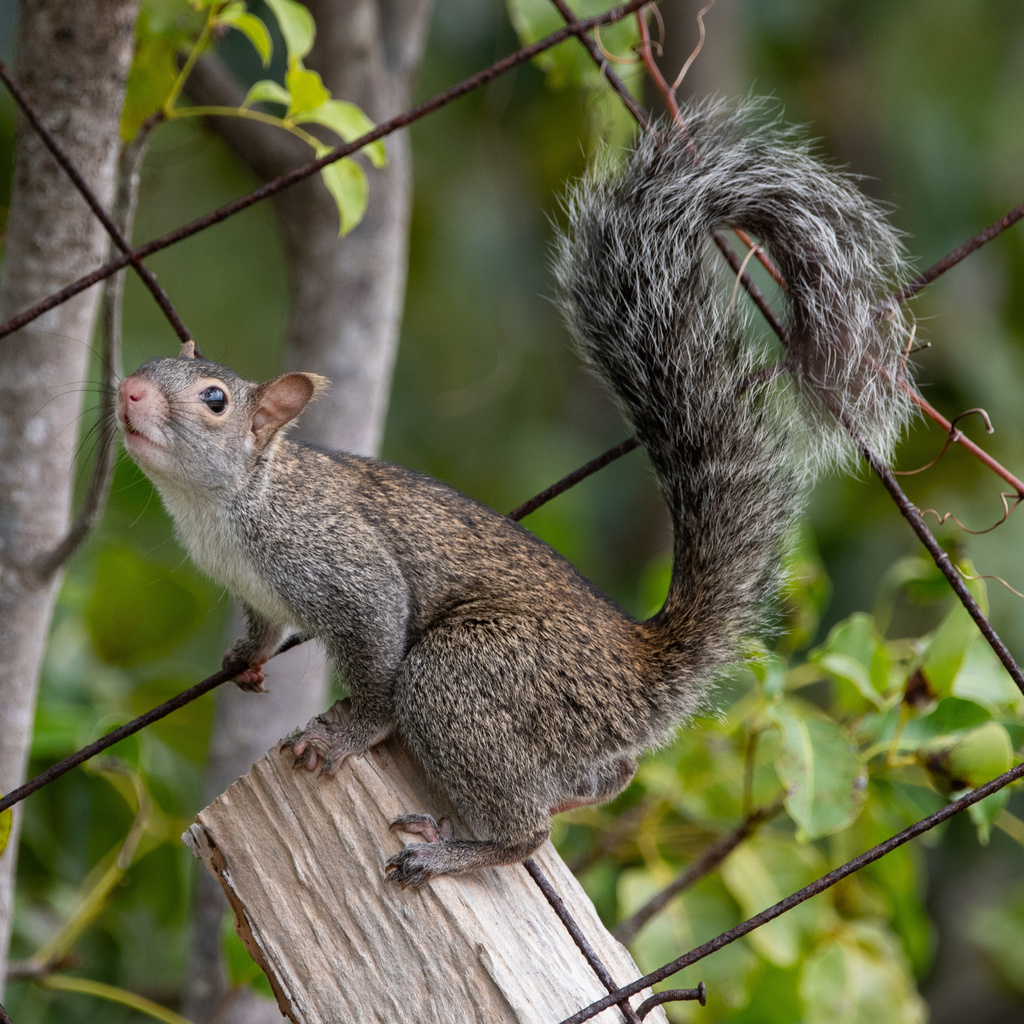
The Yucatán squirrel is a striking species with dark gray to black fur on its back and a contrasting pale or rufous underside. Its long, fluffy tail is heavily furred and often matches the body color, providing balance as it moves through trees.
It is native to the Yucatán Peninsula of Mexico and parts of Belize and Guatemala. The Yucatán squirrel prefers dry forests, pine savannas, and semi-deciduous woodlands, usually at lower elevations.
These squirrels are arboreal and active during the day, feeding on fruits, seeds, flowers, and occasionally bark. A fun fact: their striking coloration and long tails make them easy to spot despite living in densely forested areas.
Sciurus colliaei
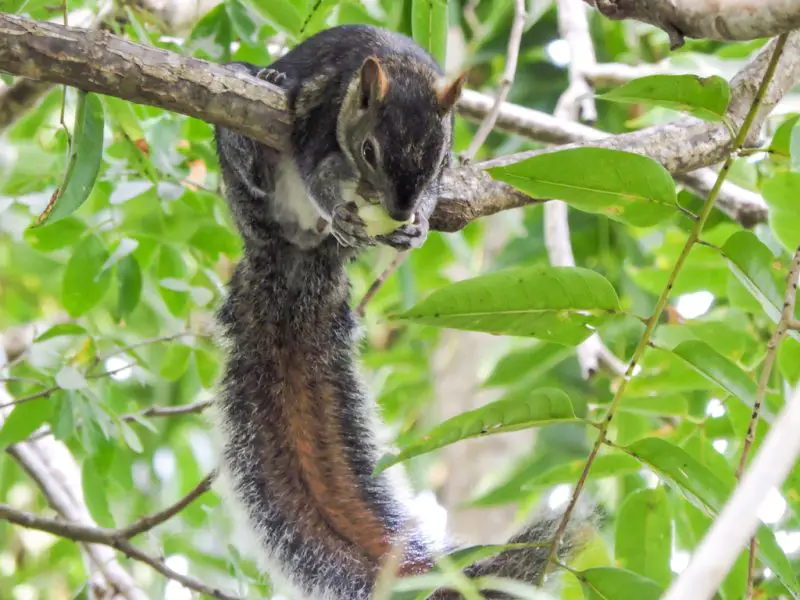
Collie’s squirrel, also known as the Collie’s tree squirrel, is a colorful species with rich reddish-brown fur and a pale, sometimes yellowish, underbelly. Its tail is long, bushy, and may have black tips or highlights depending on the individual.
It is found in western Mexico, particularly in tropical and subtropical forests along the Pacific coast, from Sinaloa to Jalisco. Collie’s squirrel thrives in both lowland and mid-elevation forests.
This diurnal species feeds on seeds, nuts, fruits, and flowers and is known for its agility in the tree canopy. A fun fact: its scientific name honors Alexander Collie, a 19th-century Scottish naturalist and naval surgeon.
Sciurus oculatus
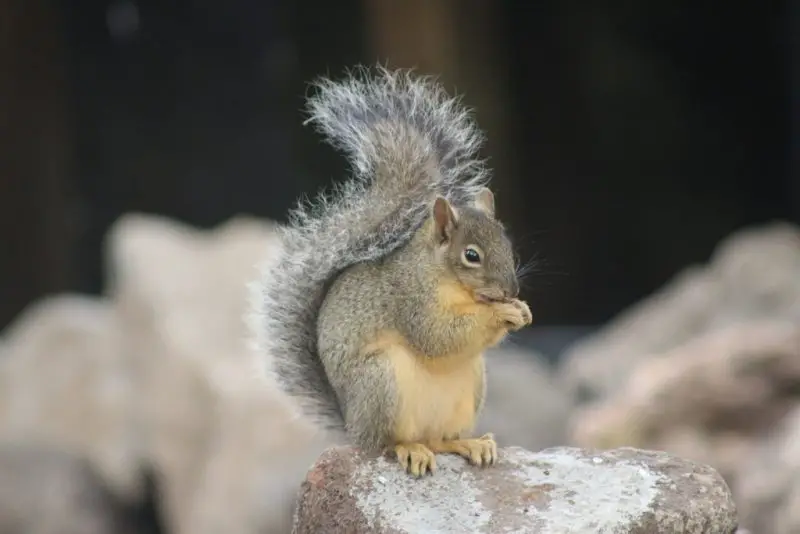
Peters’s squirrel is a medium-sized, rare species with dark gray or brown upperparts and pale underparts. It has a distinctive ring around its eyes, giving it the name “oculatus,” which means “eyed” in Latin.
It is endemic to central and southern Mexico, particularly in montane and cloud forests at elevations between 1,200 and 3,000 meters. Its preferred habitats are humid forests with dense vegetation and abundant food sources.
Little is known about its behavior due to its secretive nature, but it likely feeds on seeds, fruits, and fungi. A fun fact: Peters’s squirrel is one of the least studied North American squirrels, and its conservation status remains uncertain due to limited sightings.
Sciurus spadiceus
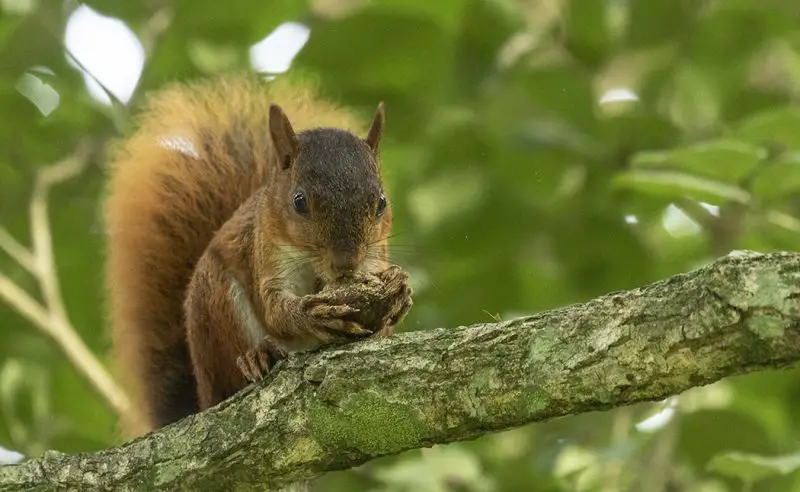
The southern Amazon red squirrel is one of the largest tree squirrels in South America. It has rich reddish-brown fur, a strong build, and a thick, bushy tail. Its vibrant coloration makes it stand out in its rainforest habitat.
This species is widespread across the southern Amazon Basin, including Brazil, Peru, Bolivia, and parts of Ecuador. It inhabits tropical rainforests and lowland jungle, favoring areas with tall canopy and dense foliage.
Southern Amazon red squirrels are active during the day and spend much of their time foraging for nuts, seeds, and fruit. A fun fact: unlike many North American squirrels, they often descend to the forest floor to forage, making them more terrestrial than expected.
Types of Squirrels in Europe
Sciurus vulgaris
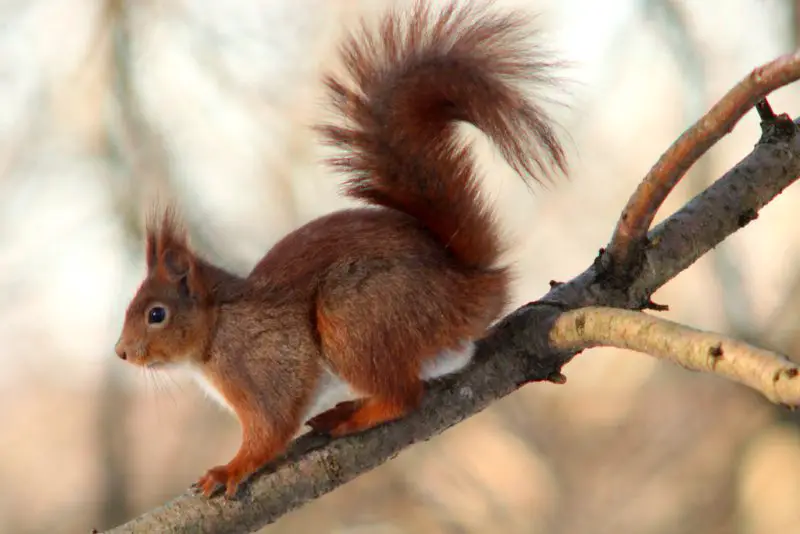
The Eurasian red squirrel is a small, agile species with a vibrant reddish coat, though its coloration can vary from reddish-brown to black depending on the region. It has a white underside, prominent ear tufts in winter, and a long, bushy tail used for balance and warmth.
This species is widely distributed across Europe and northern Asia, from the British Isles and Scandinavia to Siberia and the Korean Peninsula. It prefers coniferous and mixed woodlands but also thrives in urban parks and gardens.
Red squirrels are diurnal and feed on seeds, nuts, fungi, berries, and sometimes bird eggs. A fun fact: in areas where the invasive Eastern gray squirrel has been introduced (such as the UK), native red squirrels have sharply declined due to competition and disease.
Spermophilus citellus

The European ground squirrel, or souslik, is a small, burrowing rodent with short limbs, a blunt head, and a yellowish-brown coat marked by faint spots and streaks. It has large, black eyes and a short, thin tail.
It is native to Eastern and Central Europe, including countries like Austria, Hungary, Bulgaria, and Romania. This squirrel inhabits open grasslands, steppes, and agricultural fields, where it digs complex burrow systems.
European ground squirrels are active during the day and feed on seeds, green plants, insects, and roots. A fun fact: they hibernate for up to six months during colder seasons and are considered a symbol of protected grassland ecosystems in many parts of Europe.
Marmota marmota

The Alpine marmot is a large, stout rodent with a thick body, short legs, and dense fur ranging from gray to brown. It has small ears, sharp claws for digging, and a short, furry tail.
It is native to the European Alps and other high-elevation regions such as the Carpathians and Pyrenees. Marmots live in alpine meadows and rocky slopes above the tree line, where they create extensive underground burrows.
These sociable animals live in colonies and communicate with sharp whistles to warn of predators. Their diet includes grasses, herbs, and roots. A fun fact: Alpine marmots hibernate for up to eight months of the year and can double their body weight before winter to survive the long dormancy.
Types of Squirrels in Asia
Funambulus palmarum

The Indian palm squirrel is a small, striped species with gray-brown fur and three distinct white stripes running from head to tail along its back. Its bushy tail is roughly the same length as its body and is often held upright as it moves.
This squirrel is native to southern India and Sri Lanka and is commonly found in urban gardens, farmlands, and open forests. It adapts well to human environments and is often seen scurrying around buildings and trees in cities.
Indian palm squirrels are diurnal and feed on fruits, nuts, seeds, and small insects. A fun fact: they are considered sacred in some Hindu traditions and are protected around temples, where they are fed by devotees.
Funambulus pennantii
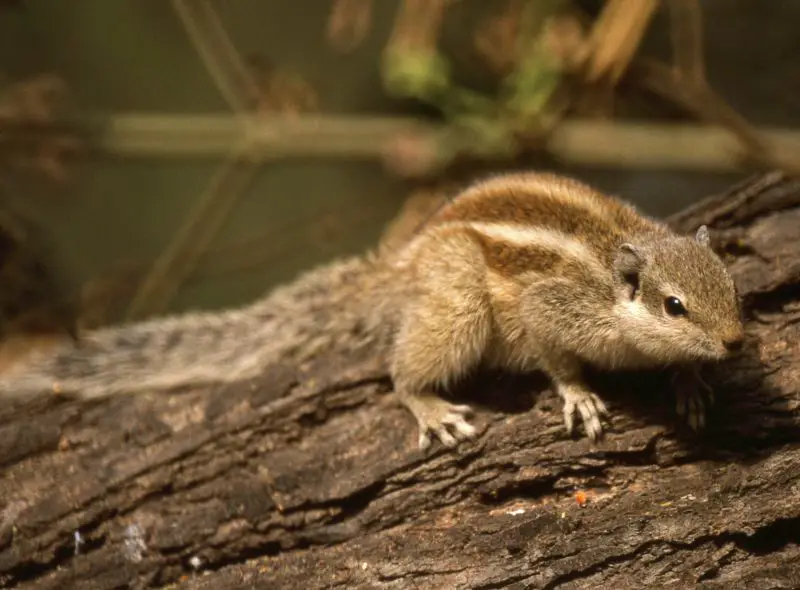
The northern palm squirrel, also known as the five-striped palm squirrel, has a slender body with light brown to grayish fur and five creamy-white stripes running longitudinally along its back. It is slightly larger than its southern cousin.
This species is widespread across northern and central India, Nepal, and parts of Pakistan. It thrives in a variety of habitats, from dry scrublands and agricultural fields to towns and temple grounds.
Northern palm squirrels are active during the day and primarily feed on grains, fruits, insects, and nuts. A fun fact: they are very vocal, often producing a sharp “chip-chip” call when alarmed or during social interactions.
Funambulus obscurus
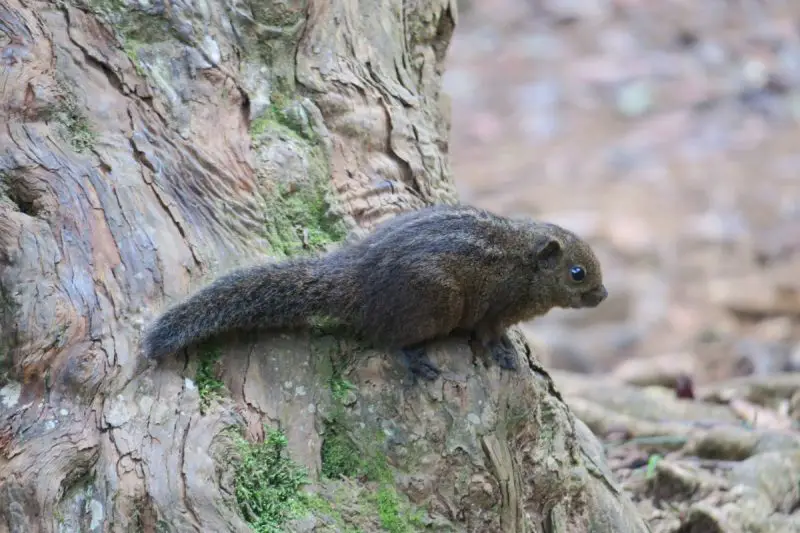
The dusky palm squirrel is a lesser-known species with dark gray to brown fur and faint or indistinct stripes compared to other palm squirrels. Its tail is bushy but not as prominently marked.
It is endemic to the island of Sri Lanka and primarily inhabits moist lowland forests and forest edges, including cultivated areas. Due to its limited range, it is considered more vulnerable to habitat loss than more widespread species.
This squirrel is arboreal and diurnal, foraging for fruits, nuts, and seeds. A fun fact: due to its secretive nature and resemblance to other squirrels, it was once confused with other Funambulus species until more thorough studies clarified its identity.
Callosciurus finlaysonii
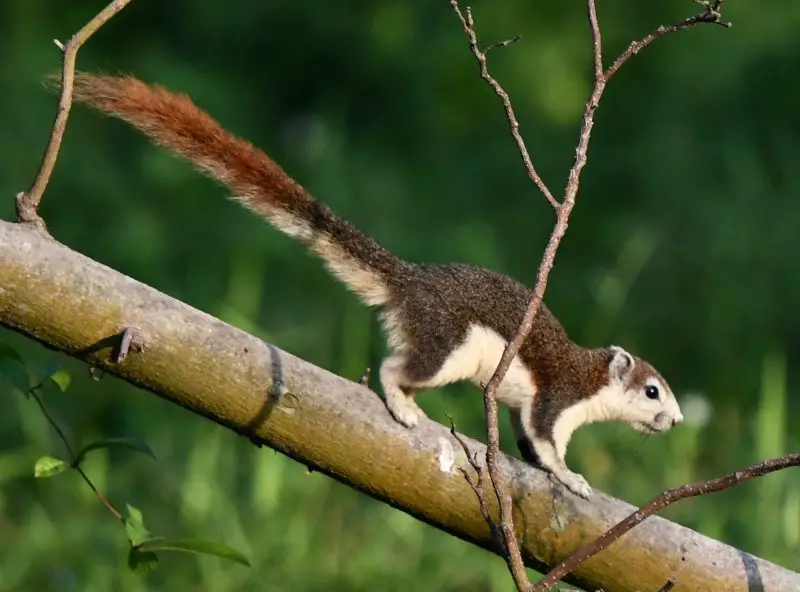
Finlayson’s squirrel, also called the variable squirrel, is famous for its incredibly diverse coloration, ranging from all white to red, black, or piebald combinations. Its fur coloration can vary drastically even within a single population.
It is native to Thailand, Cambodia, Laos, and parts of Vietnam. It inhabits forests, plantations, and urban parks, often living near human settlements where food is readily available.
This species is diurnal and feeds on fruits, seeds, flowers, and sometimes bird eggs. A fun fact: its remarkable color diversity has made it popular in the exotic pet trade and led to introductions in areas like Singapore and the Philippines.
Callosciurus erythraeus
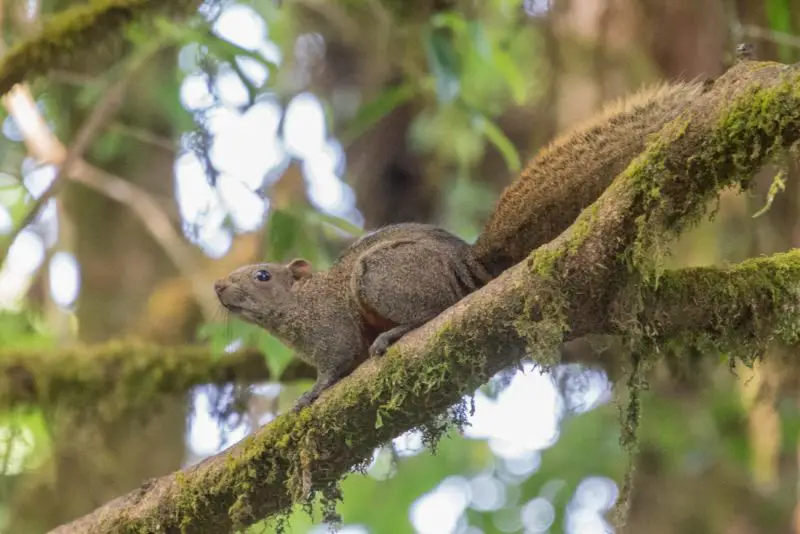
Pallas’s squirrel, or the red-bellied tree squirrel, typically has olive-brown upperparts and a reddish-orange belly, with a long, bushy tail that is darker in color. The coloration may vary across its broad range.
It is native to southern China, Taiwan, Vietnam, and parts of Southeast Asia. Pallas’s squirrel prefers subtropical and tropical forests but also thrives in secondary growth, parks, and gardens.
An agile climber and jumper, it forages for fruits, seeds, bark, and insects. A fun fact: it has been introduced to several non-native regions including Japan and Argentina, where it is considered an invasive species due to its adaptability and rapid spread.
Callosciurus notatus
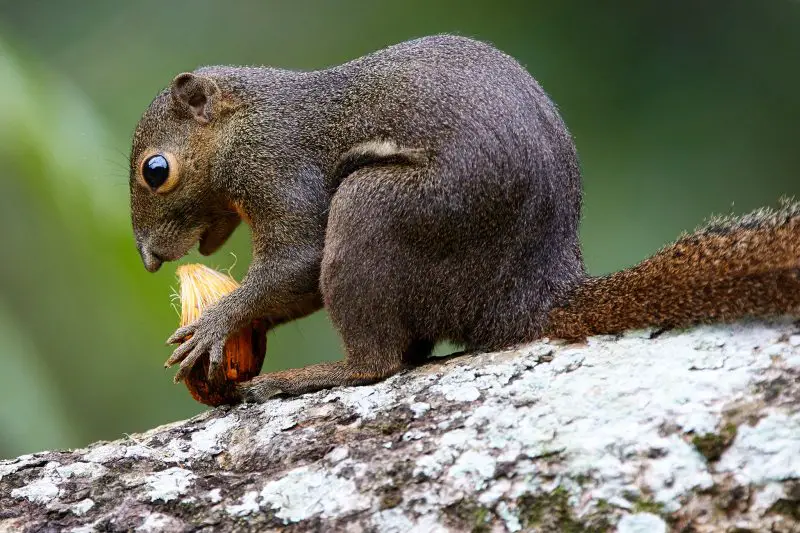
The plantain squirrel, also known as the oriental squirrel, features olive-brown fur with a distinctive reddish-orange belly and a black stripe running along each side of its body. Its bushy tail is nearly as long as its body, helping it balance during tree-to-tree jumps.
This species is native to Southeast Asia, particularly Malaysia, Indonesia, Thailand, and Singapore. It prefers tropical rainforests but has adapted well to plantations, gardens, and urban parks.
Plantain squirrels are active during the day and primarily feed on fruits, seeds, flowers, and occasionally insects. A fun fact: they are known for raiding fruit trees and are considered both a charming garden visitor and a mild agricultural pest in some regions.
Petaurista petaurista
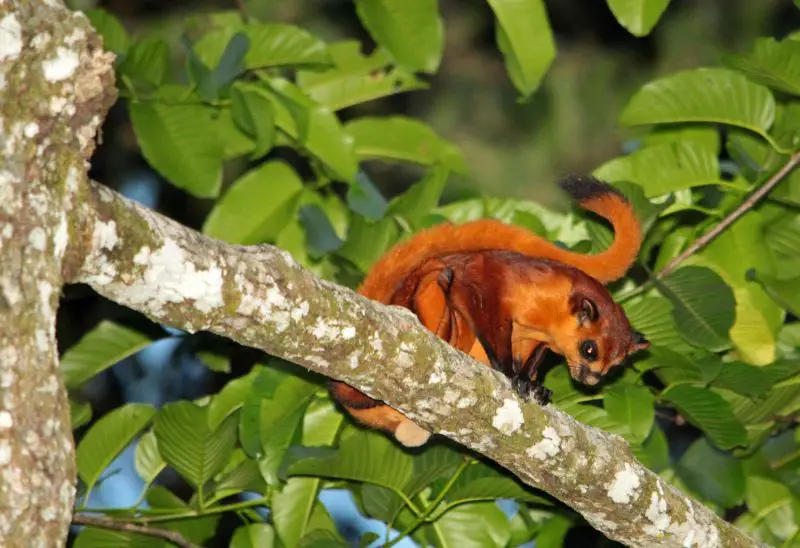
The red giant flying squirrel is one of the largest species of flying squirrels, with a body length of up to 45 cm and a tail that’s equally long. Its thick fur is reddish-brown with a paler underside, and it has large eyes for night vision.
It ranges widely from the Himalayas through Southeast Asia to the Indonesian archipelago, inhabiting mature tropical forests, woodlands, and hill forests. This species is nocturnal and relies on its large patagium (skin membrane) to glide long distances between trees.
Red giant flying squirrels feed on leaves, fruits, bark, and nuts. A fun fact: they can glide up to 75 meters in a single leap, using their tail as a rudder to steer mid-air.
Petaurista nobilis
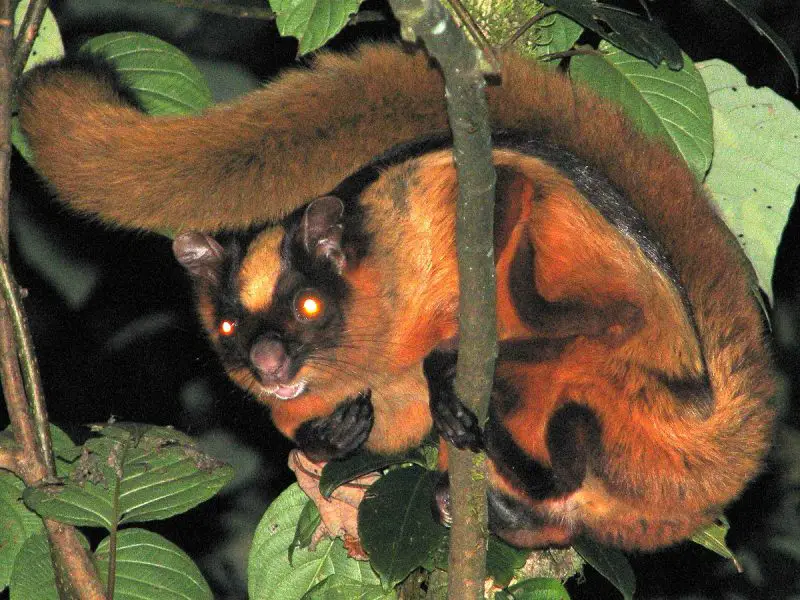
The Bhutan giant flying squirrel is a striking and rare species with a reddish-brown body, creamy underparts, and a long, bushy tail. It also possesses the gliding membrane that characterizes flying squirrels, allowing it to move silently among trees.
This species is found in the Himalayan regions of Bhutan, northeast India, and parts of southern China. It prefers dense, montane forests at high elevations, usually above 2,000 meters.
A nocturnal and herbivorous creature, it feeds on leaves, fruits, flowers, and bark. A fun fact: it is considered elusive and poorly studied due to its high-altitude habitat and secretive, night-active behavior.
Petinomys setosus
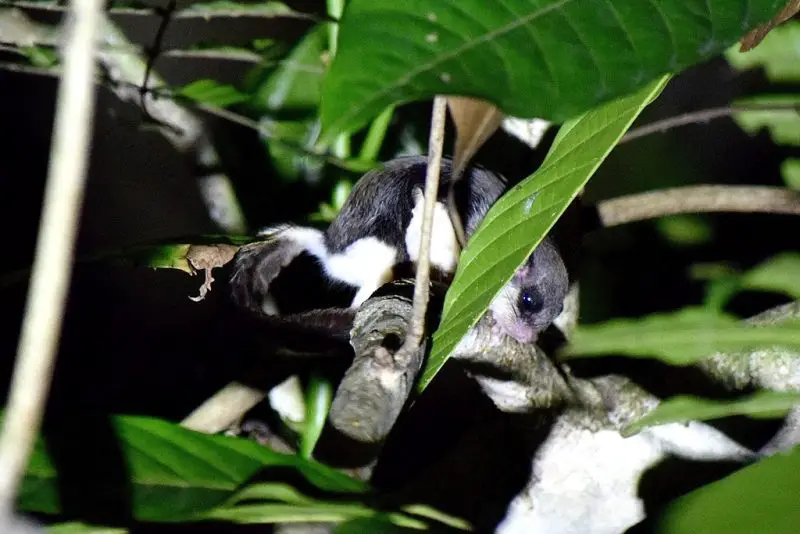
Temminck’s flying squirrel is a small and slender species with soft brown fur, a pale underbelly, and a well-developed gliding membrane. It has large eyes and a relatively narrow tail compared to other flying squirrels.
It inhabits tropical lowland and hill forests in Southeast Asia, particularly Malaysia, Indonesia, and southern Thailand. This species prefers dense forest canopies and is rarely seen due to its quiet, nocturnal habits.
Temminck’s flying squirrel feeds mainly on fruits, seeds, and leaves. A fun fact: although it’s small and quiet, it can glide impressive distances between trees thanks to its wide membrane and lightweight frame.
Hylopetes alboniger
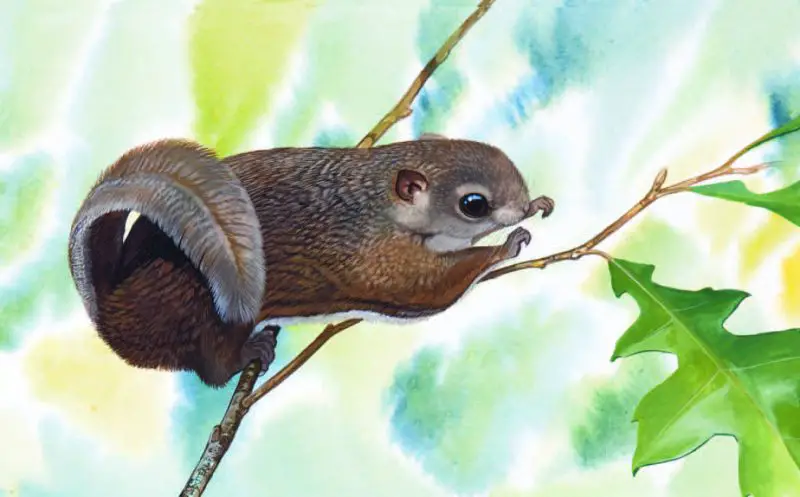
The particolored flying squirrel has a distinctive black-and-white pattern, with a dark upper body and white or grayish underparts. Its gliding membrane blends into the fur and is not always immediately visible when at rest.
This species is found in South and Southeast Asia, including India, Nepal, Myanmar, and parts of China. It lives in montane forests and high-altitude woodlands, where it uses tall trees for its gliding leaps.
A nocturnal and arboreal animal, it feeds on nuts, fruit, and tender leaves. A fun fact: its contrasting fur pattern makes it easier for researchers to identify in the wild despite its elusive and night-active nature.
Hylopetes platyurus
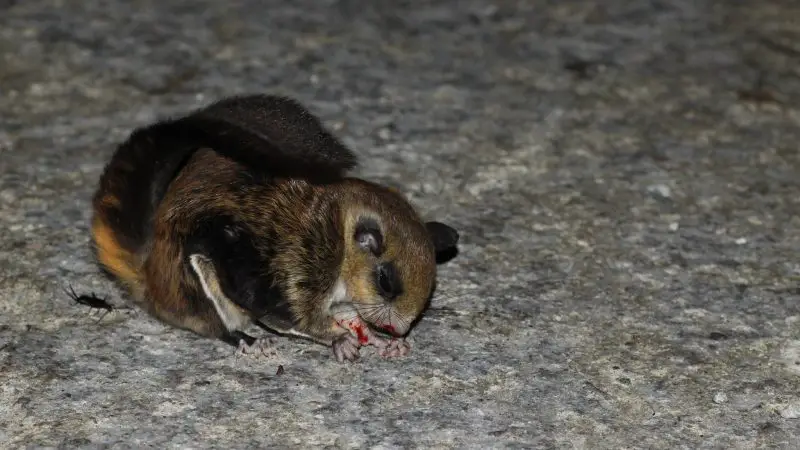
Jentink’s flying squirrel is a small, elusive species with soft, grayish-brown fur and a flattened, wide tail that aids in gliding. It features a gliding membrane extending from its wrists to its ankles, which allows it to glide silently through the forest canopy.
This squirrel is native to parts of Southeast Asia, including Indonesia and Malaysia. It prefers dense, tropical lowland and montane forests, typically staying high in the trees and rarely descending to the ground.
Nocturnal by nature, it feeds on fruits, seeds, young leaves, and sometimes bark. A fun fact: Jentink’s flying squirrel is so rarely seen that much of its behavior and ecology remains poorly documented by scientists.
Pteromys momonga

The Japanese dwarf flying squirrel is a charming and tiny species, with soft, silvery-gray fur, large black eyes, and a round face that gives it a “cute” appearance. Its body measures about 14–20 cm, with a tail almost as long as its body.
Endemic to Japan, it inhabits subalpine and boreal forests on Honshu and Kyushu islands. It builds nests in tree cavities or branch forks and uses its patagium to glide between trees.
Feeding primarily on leaves, seeds, fruits, and bark, it is most active at night. A fun fact: due to its adorable appearance, it has become a popular figure in Japanese pop culture and children’s books.
Pteromys volans
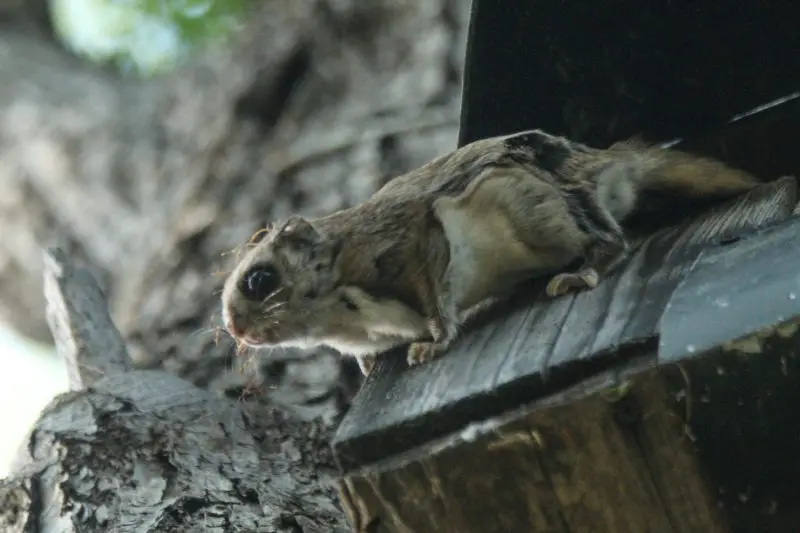
The Siberian flying squirrel is slightly larger than its Japanese cousin and is known for its thick, soft fur that insulates it from cold climates. It has a light gray coat, a white belly, and a distinctive flat tail used for steering while gliding.
This species is found in northern Eurasia, from the Baltic countries and Finland to Siberia and northeast Asia. It lives in coniferous and mixed forests, often nesting in tree holes or bird nest boxes.
Siberian flying squirrels feed on buds, catkins, leaves, and occasionally berries or fungi. A fun fact: in some regions, they are considered indicators of healthy, old-growth forests due to their specific habitat needs.
Spermophilus undulatus
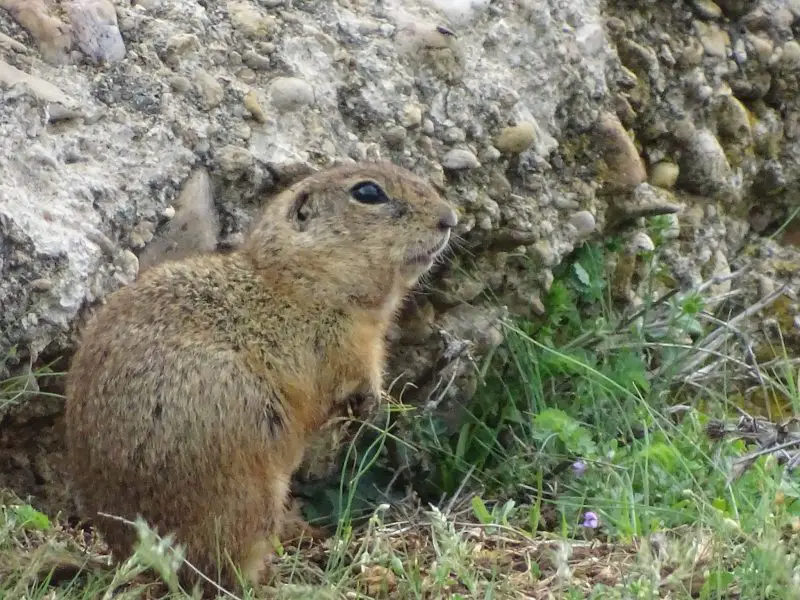
The long-tailed ground squirrel has a robust body covered in brown-gray fur with faint wave-like patterns along its back and a long, bushy tail that is unusually lengthy for a ground squirrel.
This species is native to the steppes and forest-steppe zones of eastern Russia, Mongolia, and parts of northern China. It prefers open grasslands and rocky terrain where it digs extensive burrow systems.
Feeding on grasses, seeds, and grains, it is diurnal and hibernates during the winter. A fun fact: it often sits upright like a prairie dog to watch for predators, giving it a vigilant appearance in the wild.
Spermophilus fulvus
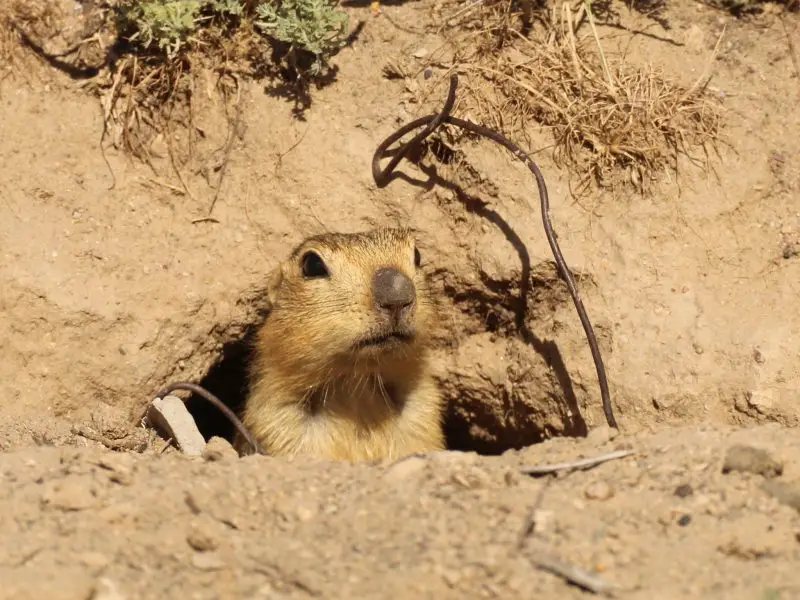
The yellow ground squirrel is a large, sturdy species with pale yellowish-brown fur and a relatively short, fluffy tail. It is one of the biggest ground squirrels in its range, with adults reaching up to 30 cm in length.
This species is distributed across Central Asia, including parts of Kazakhstan, Uzbekistan, Turkmenistan, and Iran. It inhabits semi-arid plains, deserts, and grasslands, often creating deep burrows for protection from the harsh sun and predators.
It feeds on a wide range of vegetation including grasses, roots, and cultivated crops. A fun fact: during the hottest months, it enters a state of aestivation to conserve energy and moisture.
Types of Squirrels in Africa
Paraxerus cepapi
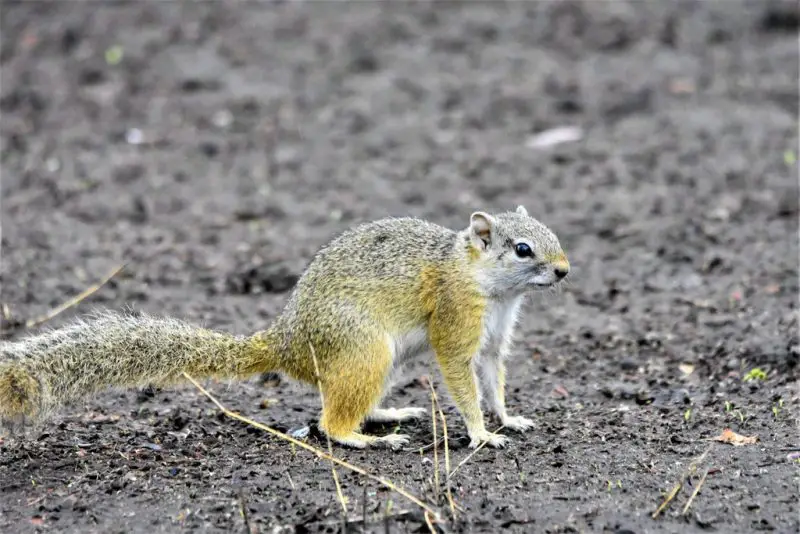
The tree squirrel Paraxerus cepapi, commonly known as the Smith’s bush squirrel, has a striking reddish-brown coat with lighter underparts and a bushy tail that helps with balance as it moves through the trees. Its agile body and sharp claws make it an excellent climber.
This species is native to southern Africa, especially in countries like South Africa, Botswana, and Namibia. It prefers savanna woodlands, scrub forests, and areas with abundant tree cover where it can forage and nest.
Active mostly during the day, it feeds on fruits, seeds, nuts, and occasionally insects. A fun fact: Paraxerus cepapi is known for its loud alarm calls, which warn other squirrels and animals of approaching predators.
Heliosciurus rufobrachium
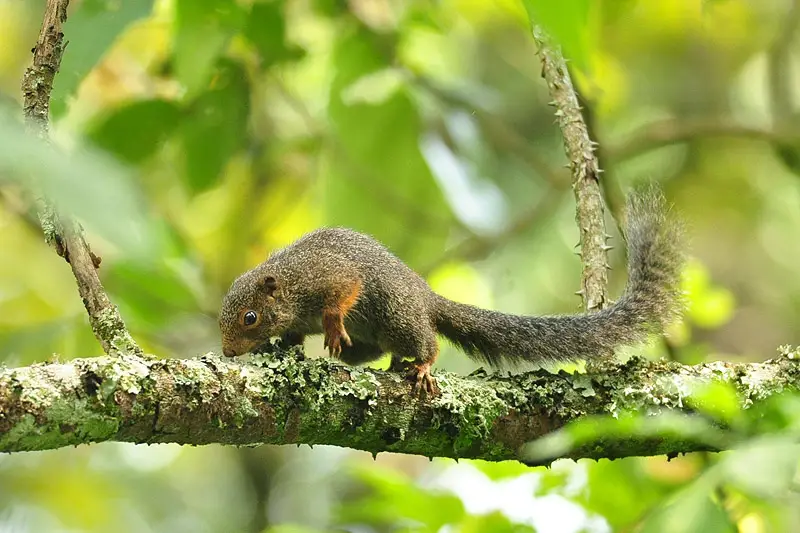
Known as the red-legged sun squirrel, this species has a distinctive reddish-orange fur on its legs and a darker brownish body. Its vibrant coloration makes it easy to identify among African squirrels.
It is found in the tropical forests of Central and West Africa, including countries like Cameroon, Gabon, and the Democratic Republic of Congo. It prefers dense forest habitats but is sometimes seen in plantations and secondary forests.
This squirrel is diurnal and primarily feeds on fruits, nuts, and seeds, but will also eat insects and bird eggs when available. A fun fact: the red-legged sun squirrel is known to cache food, hiding it in tree crevices for later consumption.
Xerus inauris
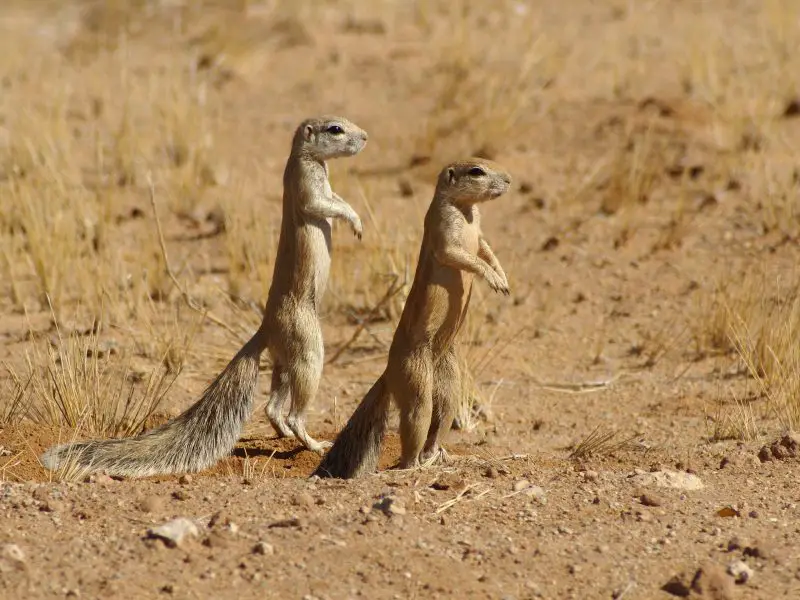
The Cape ground squirrel is a robust species with short, coarse fur that is grayish to reddish-brown and a distinctive long bushy tail often held arched over its back. Unlike tree squirrels, it spends most of its time on the ground.
Native to southern Africa, especially South Africa and Namibia, it inhabits arid savannas and deserts with sparse vegetation. It digs complex burrow systems used for shelter and raising young.
This species is highly social, living in colonies and communicating with tail flicks and vocalizations. It feeds on seeds, roots, tubers, and occasionally insects. A fun fact: Cape ground squirrels are one of the few rodents observed sunbathing to regulate their body temperature.
Xerus erythropus
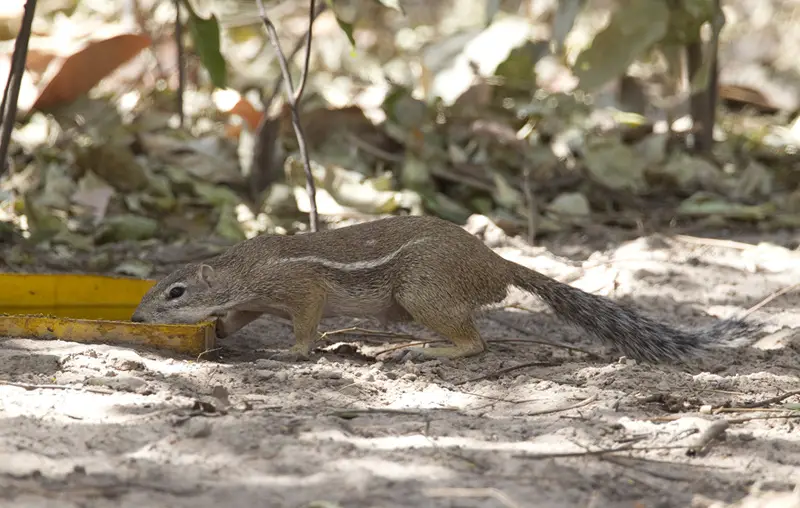
The striped ground squirrel has a light brown body with distinctive white stripes running along its sides and a bushy tail that helps with balance when sprinting across open terrain. Its sharp claws allow it to dig quickly in the soil.
It is distributed widely across West and Central Africa, favoring savanna woodlands, open grasslands, and agricultural areas. It often builds burrows under trees or in abandoned termite mounds.
Diurnal and terrestrial, it feeds on seeds, nuts, fruits, and insects. A fun fact: striped ground squirrels can stand on their hind legs to keep a lookout for predators while the rest of the group forages.

